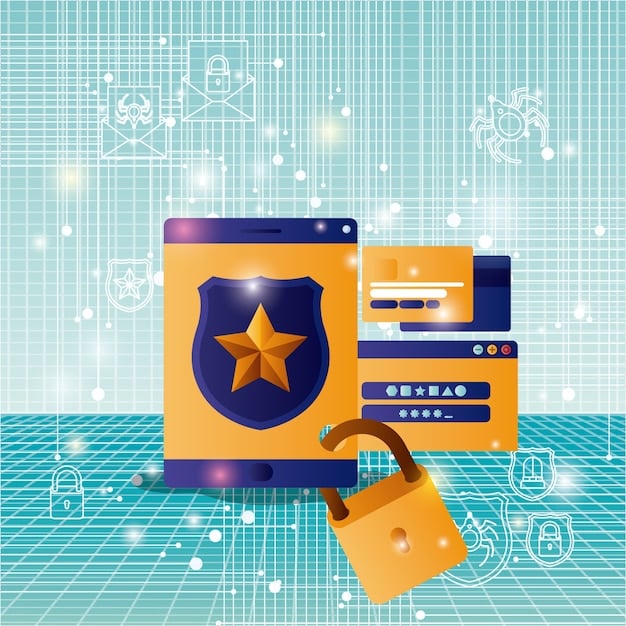Cybersecurity in Schools: DOE’s Plan to Protect Student Data

Cybersecurity Threats in Schools: How the Department of Education is Protecting Student Data focuses on the increasing cyber risks facing schools and the measures the Department of Education is implementing to safeguard student information.
Cybersecurity Threats in Schools: How the Department of Education is Protecting Student Data is a growing concern, with educational institutions increasingly becoming targets for cyberattacks. These attacks can compromise sensitive student data, disrupt school operations, and have long-lasting consequences. The Department of Education (DOE) is actively working to address these threats and protect student information through various initiatives and strategies.
Understanding the Rising Cybersecurity Threats in Schools
Schools hold a vast amount of sensitive data, including student records, personal information, and financial details. This makes them attractive targets for cybercriminals. Understanding the nature and scope of these threats is crucial for developing effective cybersecurity strategies.
Common Types of Cyberattacks Targeting Schools
Schools face a variety of cyber threats, each with its own potential impact. Awareness of these threats is the first step in building a strong defense.
- Ransomware Attacks: Cybercriminals encrypt school data and demand a ransom for its release.
- Data Breaches: Unauthorized access to sensitive student and staff information.
- Phishing Scams: Deceptive emails or messages designed to trick individuals into revealing confidential information.
- Malware Infections: Introduction of malicious software that can damage systems and steal data.

The Impact of Cybersecurity Breaches on Education
The consequences of a successful cyberattack can be significant, affecting not only the school’s operations but also the well-being of its students and staff.
Beyond the immediate financial costs associated with incident response and recovery, cybersecurity breaches can erode trust within the school community. Parents may become hesitant to share sensitive information, and students may feel vulnerable. The reputational damage can also make it difficult for schools to attract and retain staff.
In conclusion, recognizing the diverse forms of cyberattacks and their extensive repercussions is paramount for schools to proactively fortify their digital defenses and secure their educational environments.
DOE Initiatives to Strengthen School Cybersecurity
The Department of Education recognizes the urgent need to protect schools from cyber threats and has launched several initiatives to bolster their cybersecurity posture.
The DOE’s efforts are focused on providing resources, guidance, and support to help schools implement effective cybersecurity measures and mitigate risks.
Cybersecurity Grant Programs
The DOE offers grant programs to help schools fund cybersecurity improvements, addressing critical vulnerabilities and enhancing their overall security infrastructure.
These grants can be used to purchase new security software, upgrade existing systems, and provide training to staff on cybersecurity best practices. The funding also supports the development and implementation of comprehensive cybersecurity plans tailored to the specific needs of each school district.
Resources and Training for Educators
Providing educators with the necessary knowledge and skills to identify and respond to cyber threats is a key component of the DOE’s strategy.
- Cybersecurity Awareness Training: Programs designed to educate staff on common threats and how to avoid them.
- Incident Response Planning: Guidance on how to develop and implement effective incident response plans.
- Best Practices Guides: Providing schools with detailed recommendations on cybersecurity best practices.
The DOE’s initiatives aim to create a culture of cybersecurity awareness within schools, where everyone understands their role in protecting sensitive information. By empowering educators with the right tools and knowledge, the DOE is helping to create a more secure learning environment for students.
Key Strategies for Schools to Protect Student Data
While the DOE provides valuable support, individual schools must also take proactive steps to protect student data. A multi-layered approach that combines technical safeguards with user awareness is essential.
Implementing robust security measures and fostering a culture of cybersecurity awareness can significantly reduce the risk of successful attacks.

Implementing Strong Password Policies
Strong passwords are the first line of defense against unauthorized access to school systems and data. Implementing and enforcing robust password policies is crucial.
Password policies should require users to create complex passwords that include a combination of uppercase and lowercase letters, numbers, and symbols. Regular password changes should also be enforced. Additionally, schools should educate users on the importance of avoiding easily guessable passwords and protecting their credentials.
Regularly Updating Software and Systems
Keeping software and systems up to date is essential for patching security vulnerabilities that cybercriminals can exploit. Regular updates should be a priority for all school devices.
Schools should establish a process for promptly installing security updates and patches for all software, operating systems, and network devices. Automating the update process whenever possible can help ensure that updates are applied consistently and efficiently. Regular vulnerability scans can also help identify and address potential weaknesses in the school’s IT infrastructure.
In summary, implementing strong password policies and maintaining up-to-date software systems are two pivotal strategies for schools to fortify their defenses against potential cybersecurity breaches and safeguard sensitive student data.
The Role of Parents and Students in Cybersecurity
Cybersecurity is a shared responsibility, and parents and students play a vital role in protecting school data. Educating them about online safety and responsible technology use is essential.
Involving parents and students in cybersecurity efforts helps create a more secure and aware school community.
Teaching Students About Online Safety
Incorporating online safety education into the curriculum can help students develop the skills and knowledge they need to navigate the digital world safely.
- Cyberbullying Awareness: Educating students about the dangers of cyberbullying and how to report it.
- Phishing Prevention: Teaching students how to identify and avoid phishing scams.
- Responsible Social Media Use: Promoting responsible online behavior and privacy settings.
Engaging Parents in Cybersecurity Education
Providing parents with resources and information about cybersecurity can help them support their children’s online safety and protect school data at home.
Schools can host workshops or webinars for parents on topics such as internet safety, social media privacy, and parental control tools. Providing parents with tips and resources can empower them to have open and ongoing conversations with their children about online safety.
Future Trends in Cybersecurity for Education
The cybersecurity landscape is constantly evolving, and schools must stay ahead of emerging threats. Investing in advanced security technologies and strategies is crucial for protecting student data in the long term.
Staying informed about future trends and adapting cybersecurity practices accordingly will help schools maintain a strong defense against evolving cyber threats.
Artificial Intelligence (AI) in Cybersecurity
AI-powered security solutions can automate threat detection and response, providing schools with enhanced protection against sophisticated cyberattacks.
AI algorithms can analyze network traffic, user behavior, and other data to identify anomalies and potential security breaches. These tools can also automate incident response actions, such as isolating infected devices and blocking malicious traffic. Implementing AI-powered cybersecurity solutions can help schools detect and respond to threats more quickly and effectively.
Cloud-Based Security Solutions
Cloud-based security solutions offer scalable and cost-effective protection for school data and systems. These solutions can provide advanced threat detection and prevention capabilities without requiring significant investment in on-premises infrastructure.
Cloud-based firewalls, intrusion detection systems, and data loss prevention tools can help schools secure their data and applications in the cloud. These solutions can also provide centralized management and monitoring, making it easier for IT staff to maintain a consistent security posture across the entire school district.
Measuring the Effectiveness of Cybersecurity Measures
It’s crucial to evaluate the effectiveness of implemented cybersecuritymeasures to ensure they are providing adequate protection and to identify areas for improvement.
Regular assessments and audits can help schools identify vulnerabilities and track progress in strengthening their cybersecurity posture.
Regular Security Audits and Assessments
Conducting regular security audits and assessments can help schools identify vulnerabilities in their systems and processes. These audits should be performed by qualified security professionals who can provide independent and objective assessments.
The results of the audits should be used to develop a remediation plan to address identified vulnerabilities and improve the school’s overall security posture. Regular penetration testing can also help identify weaknesses in the school’s network and systems.
Tracking Key Cybersecurity Metrics
Monitoring key cybersecurity metrics can provide valuable insights into the effectiveness of security measures and help identify areas that need improvement.
- Time to Detect and Respond to Incidents: Measuring how quickly threats are detected and resolved.
- Number of Successful Attacks: Tracking the number of successful cyberattacks and their impact.
- User Awareness Training Completion Rates: Monitoring the percentage of staff and students who have completed cybersecurity awareness training.
| Key Point | Brief Description |
|---|---|
| 🛡️ DOE Initiatives | Grant programs and training resources for schools. |
| 🔑 Password Policies | Implementing strong and regularly updated passwords. |
| 👨🏫 Educator Training | Providing educators with cybersecurity awareness and skills. |
| 🤖 AI in Cybersecurity | Leveraging AI for advanced threat detection and response. |
FAQ
▼
Schools commonly face ransomware, data breaches, phishing, and malware, all compromising sensitive data and disrupting operations.
▼
The DOE offers grant programs for cybersecurity improvements and provides resources and training for educators on best practices.
▼
Strong passwords are the first defense against unauthorized access, safeguarding systems and sensitive student information from breaches.
▼
Students can learn about online safety, avoid phishing scams, and practice responsible social media habits to enhance overall security.
▼
AI automates threat detection and response, using algorithms to analyze data and quickly address potential security breaches effectively.
Conclusion
Protecting student data from cybersecurity threats is an ongoing challenge that requires a collaborative effort from the Department of Education, schools, parents, and students. By implementing robust security measures, fostering a culture of cybersecurity awareness, and staying ahead of emerging threats, we can create a safer and more secure learning environment for all.





